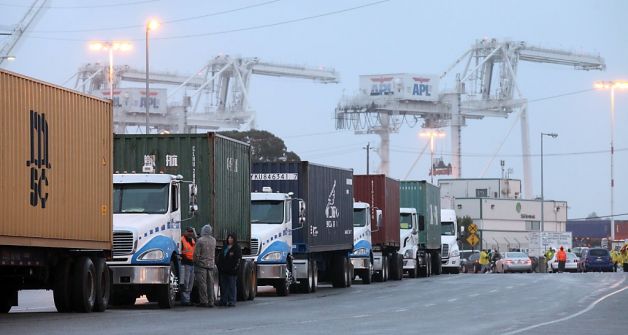West Coast Still Struggling
As reported by the AgTC, some West Coast ports are still struggling with congestion and backlog. With the limited availability of chassis, the entire unloading process takes longer and, as a result, terminals charge transaction fees and truckers charge stand-by fees for waiting at the gates.
Some carriers have even decided to skip vessel calls to the Port of Oakland and the Port of Portland due to the congestion, deciding instead to call on Tacoma and Seattle. Both ports will have to work hard to decrease the backlog and make their loading/unloading processes more efficient in order to gain back lost business.

Agriculture Transportation Coalition
www.agtrans.org 202-783-3333 | info@agtrans.org
AgTC: West Coast Port Update
August 3, 2015
West Coast Ports, particularly the Port of Oakland continue to be backlogged. Chassis availability issues have caused a domino effect on the industry–with limited equipment, terminals charge gate transaction fees, and drivers charge stand-by fees as a result of long waits at the gate. Of course, these costs get passed along to the shipper. Click here for a summary on new fee structures from one of our member companies.
MOL, a G6 ocean carrier, recently announced that it will be skipping a call in Oakland due to the congestion. Oakland will soon have more ILWU workers-the Pacific Maritime Association (PMA) agreed to promote 100 casual workers to registered longshore status, and hire an additional 400 casuals. Unlike all the other West Coast locals, the Oakland ILWU local decided that casuals would not be allowed to drive trucks on the terminal, which created this labor “shortage” and necessitate these promotions and new hires.
Ports Resources.Our AgTC Members-Only Real Time Port Disruption Monitor is back. Email mail@agtrans.org for the password. Click here to view the trucker gate cameras for each terminal at the Port of Oakland.
Face-to-Face with ILWU in LA/Long Beach 30 AgTC members will meet with ILWU International Leadership and the Presidents of Locals 13, 63, and 94 in Long Beach this Wednesday for an AgTC-ILWU meeting. No press, ports, terminal operators, etc. The day includes frank discussion, a terminal tour, lunch provided by the ILWU, and an AgTC wrap-up. We hope to have similar meetings in Oakland and the Pacific Northwest. All AgTC members will receive a full recap.
Portland. Due to the inability to demonstrate efficient loading and unloading of ships at the Port of Portland’s T6 container terminal, Hanjin and Hapag Lloyd, the last major container services in the Columba River, discontinued vessel calls. This necessitates the transfer of virtually all Oregon origin and destined cargo through the Ports of Tacoma and Seattle (now merged into the NW Seaport Alliance) and drayage by a truck up and down the busy I-5 corridor. The alternative is rail; Northwest Container is loading Oregon cargo at two locations, Portland and Boardman, both with direct rail service to Tacoma. There is continued container service, once a month of approximately 200 containers, on Westwood, an excellent niche carrier. Thus far, the T6 terminal/labor performance for that vessel call has been insufficient; almost 2 days to load approximately 120 containers, with a number of hiccups. We’re standing by to monitor the next Westwood port call. We fear that unless this goes more smoothly than the last, there will be no additional vessel service into T6, despite vigorous efforts by the Port of Portland to recruit additional carriers.
Oregon Trade and Logistics Initiative. The Governor of Oregon, concerned about the impact of loss of direct vessel calls in the Columbia River, has initiated a Trade and Logistics Initiative. The AgTC is playing an active role, assisting in conducting six Workshops around Oregon (Portland, Redmond, Hermiston last week; Ontario,,Albany, Medford next week) attracting agriculture, forest products, importers and manufacturers. To register and info click here The objective is to find options by which cargo can be transited to Seattle and Tacoma ports at the lowest cost (until direct vessel calls can be reinstated). Current trucking hours of service and other regulations severely impact Oregon and Eastern Washington agriculture exporters who are attempting to access Seattle-Tacoma efficiently. The ultimate solution (or “work around”) may involve expanded rail service, with load points down the Willamette Valley, as both UP and BNSF have track serving Eastern Oregon and Willamette Valley, directly to Puget Sound ports.
We will provide updates on other ports that are still struggling to get back to “normal”: Norfolk, Seattle/Tacoma, etc.










